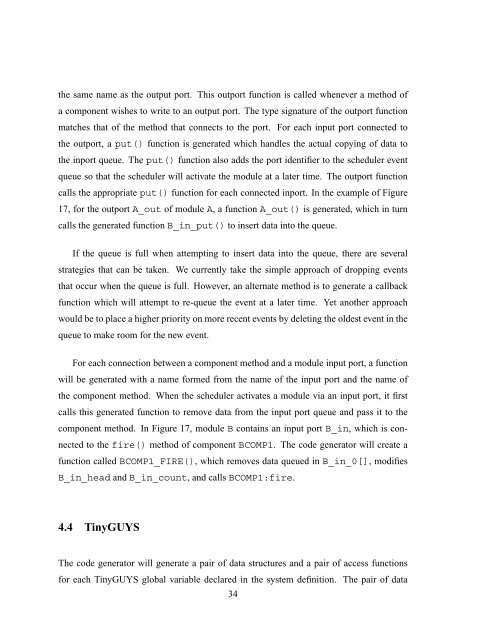Design and Implementation of TinyGALS: A Programming Model for ...
Design and Implementation of TinyGALS: A Programming Model for ...
Design and Implementation of TinyGALS: A Programming Model for ...
You also want an ePaper? Increase the reach of your titles
YUMPU automatically turns print PDFs into web optimized ePapers that Google loves.
the same name as the output port. This outport function is called whenever a method <strong>of</strong><br />
a component wishes to write to an output port. The type signature <strong>of</strong> the outport function<br />
matches that <strong>of</strong> the method that connects to the port. For each input port connected to<br />
the outport, a put() function is generated which h<strong>and</strong>les the actual copying <strong>of</strong> data to<br />
the inport queue. The put() function also adds the port identifier to the scheduler event<br />
queue so that the scheduler will activate the module at a later time. The outport function<br />
calls the appropriate put() function <strong>for</strong> each connected inport. In the example <strong>of</strong> Figure<br />
17, <strong>for</strong> the outport A_out <strong>of</strong> module A, a function A_out() is generated, which in turn<br />
calls the generated function B_in_put() to insert data into the queue.<br />
If the queue is full when attempting to insert data into the queue, there are several<br />
strategies that can be taken. We currently take the simple approach <strong>of</strong> dropping events<br />
that occur when the queue is full. However, an alternate method is to generate a callback<br />
function which will attempt to re-queue the event at a later time. Yet another approach<br />
would be to place a higher priority on more recent events by deleting the oldest event in the<br />
queue to make room <strong>for</strong> the new event.<br />
For each connection between a component method <strong>and</strong> a module input port, a function<br />
will be generated with a name <strong>for</strong>med from the name <strong>of</strong> the input port <strong>and</strong> the name <strong>of</strong><br />
the component method. When the scheduler activates a module via an input port, it first<br />
calls this generated function to remove data from the input port queue <strong>and</strong> pass it to the<br />
component method. In Figure 17, module B contains an input port B_in, which is con-<br />
nected to the fire() method <strong>of</strong> component BCOMP1. The code generator will create a<br />
function called BCOMP1_FIRE(), which removes data queued in B_in_0[], modifies<br />
B_in_head <strong>and</strong> B_in_count, <strong>and</strong> calls BCOMP1:fire.<br />
4.4 TinyGUYS<br />
The code generator will generate a pair <strong>of</strong> data structures <strong>and</strong> a pair <strong>of</strong> access functions<br />
<strong>for</strong> each TinyGUYS global variable declared in the system definition. The pair <strong>of</strong> data<br />
34
















